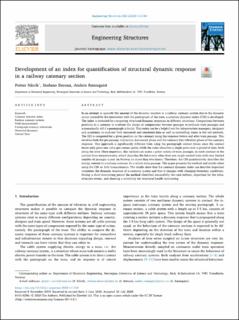| dc.contributor.author | Nåvik, Petter Juell | |
| dc.contributor.author | Derosa, Stefano | |
| dc.contributor.author | Rønnquist, Anders | |
| dc.date.accessioned | 2021-02-19T09:44:38Z | |
| dc.date.available | 2021-02-19T09:44:38Z | |
| dc.date.created | 2020-08-03T12:44:15Z | |
| dc.date.issued | 2020 | |
| dc.identifier.citation | Engineering structures. 2020, 222 . | en_US |
| dc.identifier.issn | 0141-0296 | |
| dc.identifier.uri | https://hdl.handle.net/11250/2729124 | |
| dc.description.abstract | In an attempt to quantify the amount of the dynamic reaction in a railway catenary system due to the dynamic action created by the interaction with the pantograph of the train, a catenary dynamic index (CDI) is developed. The index is intended for comparing structural dynamic responses in different situations. Comparisons between positions in a catenary to evaluate the design or comparisons between passages to evaluate train passages and automatically tell if a pantograph is faulty. This index can be a helpful tool for infrastructure managers, designers and academics to evaluate both measured and simulated data as well as controlling trains in the rail network. The CDI is computed for a given position on the catenary using the response before and after train passage. This involves both the pre-passage interaction dominated phase and the catenary free vibration phase of the catenary response. This approach is significantly different from using the pantograph contact forces since the contact forces only gives one value per contact point, while the index describes a single point over a period of time, both along the wire. More important, this method can assess a great variety of train passages, in stark contrast to the contact force measurements, which describes the behaviour often from one single control train with very limited number of passages a year (in Norway no more than two times). Therefore, the CDI quantitatively describes the energy content in a railway catenary for a whole train passage. This paper presents the method and results when using the CDI on field measurements. The results show that the catenary dynamic index can describe important variations the dynamic response of a catenary system and that it changes with changing boundary conditions. During a short monitoring period the method identified successfully two real outliers, important for the infrastructure owner, and showing a suitability for structural health monitoring. | en_US |
| dc.language.iso | eng | en_US |
| dc.publisher | Elsevier | en_US |
| dc.rights | Navngivelse 4.0 Internasjonal | * |
| dc.rights.uri | http://creativecommons.org/licenses/by/4.0/deed.no | * |
| dc.title | Development of an index for quantification of structural dynamic response in a railway catenary section | en_US |
| dc.type | Peer reviewed | en_US |
| dc.type | Journal article | en_US |
| dc.description.version | publishedVersion | en_US |
| dc.source.pagenumber | 9 | en_US |
| dc.source.volume | 222 | en_US |
| dc.source.journal | Engineering structures | en_US |
| dc.identifier.doi | 10.1016/j.engstruct.2020.111154 | |
| dc.identifier.cristin | 1821304 | |
| dc.description.localcode | © 2020 The Authors. Published by Elsevier Ltd. This is an open access article under the CC BY license (http://creativecommons.org/licenses/BY/4.0/). | en_US |
| cristin.ispublished | true | |
| cristin.fulltext | original | |
| cristin.qualitycode | 2 | |

